
“An Impartial Overview,” Jawbox’s chosen title for their reunion tour, works only in theory. Perhaps the band themselves can look upon their back catalog with the dry objectivity promised by that lyric from “Chinese Fork Tie,” but for fans of the band, approaching the group’s first proper tour dates since 1997 (a humble, presumably unintended finale on Valentine’s Day in Rochester, NY) with anything close to detachment is an impossible order. The 2009 performance on Late Night with Jimmy Fallon was both blessing and curse: it was wonderful to see Jawbox’s four members on the same stage again, gracing a new audience with the brilliance of “Savory,” but what if that short set was truly the end? For the next decade, I crossed names off the wish list of bands I’d initially missed due to youth or stupidity, but Jawbox remained in all caps. Its members weren’t all hibernating: J. Robbins added to his considerable catalog with Office of Future Plans and his just-issued solo album Un-Becoming while the instrumental Bells≥ pushed Zach Barocas’s considerable chops. There were reasons not to reunite, of course, but if their former single-mates Jawbreaker could do it, why not Jawbox? By the time “An Impartial Overview” was finally announced in January, how could impartiality be expected?

It’s been 23 years since I could conceivably have been impartial about Jawbox. I first knowingly heard the DC band on MTV’s 120 Minutes, presumably with the July 7th, 1996 debut of the human Kerplunk video for “Mirrorful” from their 1996 self-titled album. Their appeal was immediate yet lasting: urgent, melodic guitar rock loaded with lyrical and compositional depth. The reason I taped 120 Minutes was to find music that offered more, that engaged me more, and “Mirrorful” did just that. The distrust of the slanted histories (“Annex and index / Mirror too perfect”) I undoubtedly read that year in social studies resonated strongly, but the combination of J. Robbins and Bill Barbot’s parrying guitar lines, Kim Coletta’s clear and forceful bass, and Zach Barocas’s ingenious fills made me pick up Jawbox on my next CD-shopping excursion. And as was the case with many of the indie/alternative bands I found via 120 Minutes or college radio, the album tracks grabbed me as much, if not more than the lead single. Wrapping my head around the complex rhythms of “Won’t Come Off,” the explosive dynamics of “Desert Sea,” and the lyrical enigmas of “Absenter” kept Jawbox in rotation and prompted purchases of their earlier records, which offered different, but similarly rewarding combinations of immediacy and lasting intrigue.

Jawbox announced their break-up on their web site in 1997, but said site offered a literal gateway to like-minded music. Kim Coletta and Bill Barbot ran DeSoto Records (inheriting it from the members of Edsel), and every order I made with DeSoto brought along a new favorite band: Burning Airlines, Shiner, Juno, The Dismemberment Plan, Beauty Pill, Faraquet, and others. In contrast to many other independent labels, their release schedule was manageable and their hit rate was near-flawless. If they released it, I would buy it and almost certainly love it. None of these bands were carbon copies of Jawbox, which makes sense: if musicians were smart enough to like Jawbox (and in turn, be liked by Jawbox), they were smart enough to do something different and compelling on its own accord. (That statement applies to DeSoto bands, but not all of the bands influenced by Jawbox. The deepest reaches of my CD collection will attest that it was quite possible to sound very much like Jawbox without retaining their creative spirit.) It’s worth noting how much timing factors into my Jawbox-centric worldview: if I’d been five years older and/or had cooler friends, I would’ve learned about Fugazi first, then worked my way through the Dischord catalog and found out about Jawbox that way. Instead, the major label gambits of both Jawbox and Shudder to Think introduced them first and encouraged me to work my way back to Dischord.

Jawbox’s legacy in 2019 resides primarily within the context of intelligent, inventive guitar rock (that doesn’t skimp on melody), which, as ever, does not dominate the zeitgeist. A flash of mainstream influence came when the Deftones covered “Savory,” but Jawbox’s musical DNA lingers on a smaller scale. Many of my favorites from Exploding in Sound Records’ roster, past and present, display some degree of Jawbox genetics: Grass Is Green, Speedy Ortiz, Two Inch Astronaut. Other bands, like the ever-recommended Hammer No More the Fingers, have come into my radar thanks to J. Robbins’ production credits. Availability is the other side of legacy, and fortunately Jawbox’s records have been reissued by DeSoto via Dischord and remain in print. These reissues are not extravagant, vault-emptying collections. True to the Dischord mindset, these carefully remastered pressings exist to maintain a presence, to allow people to hear the records if they so choose. While it would be nice if Jawbox were the beneficiaries of a major critical re-evaluation, the concept of revisiting these records with fresh ears is a conundrum to me: at no point did I stop listening to Jawbox.
Judging by the first two official shows of An Impartial Overview, I am not alone in maintaining my Jawbox fandom for the last twenty years. After a warm-up show in Baltimore, Jawbox came up to Cambridge to play two nights at The Sinclair. It took time for the venue to fill up the first night—I joked about babysitters running late—but by the time Jawbox hit the stage, personal space was at a minimum. The opening acts for the respective shows deserve mention. Friday’s opener was the Philadelphia-based Second Letter, whose lineup includes Burning Airlines drummer Peter Moffett (who also handles the drums for J. Robbins’ Un-Becoming and Bill Barbot’s new band Foxhall Stacks). The five-piece delivered a layered combination of epic guitar rock, power pop, and early ’00s post-emo. My interest waxed when they leaned into the bigger riffs and waned when I recalled bands like The Gloria Record. The opener for the second night was Brooklyn’s LAPêCHE, whose two most recent releases (the 2017 LP The Second Arrow and the 2019 EP Spirit Bunnies) were recorded by J. Robbins. Vocalist/guitarist Krista Holly Diem maintained a careful balance of melancholy and melody over her band’s considered arrangements, and Spirit Bunnies is worthy, quick introduction.

As Jawbox launched into “Mirrorful” to start their Friday set—a fitting rewind to my initial introduction—I was immeasurably pleased that all four members were on stage. I’ve seen enough reunited/reformed bands with substitutes to appreciate a full turnout, and all four members of Jawbox were essential to this equation. I’ve seen J. Robbins play some of these songs acoustically, drawing out their melodic depth, but on these nights he was totally galvanized. Bill Barbot had exited from Burning Airlines by the first time I caught that band, so seeing him on stage helped me gain a new appreciation for and understanding of his role in Jawbox. Not only does he excel as a foil (he absolutely nails the falsetto outro of “Cornflake Girl”) and periodic lead vocalist (“Tongue” and “Breathe”), his heavy chord progressions are critical to songs like “Desert Sea.” I tried picturing any other drummer navigating the minefields Zach Barocas laid out on For Your Own Special Sweetheart and Jawbox and simply could not; in hindsight it makes perfect sense that Jawbox could not continue after his departure in 1997. Kim Coletta was the stand-out of both evenings. I’d never seen a performer beam with such joy, a contagious feeling that was explained by a second-night anecdote about her current day-job of teaching third-graders. In contrast with wrangling a room full of nine-year-olds, playing bass on stage for the first time in over two decades has to feel pretty great.
In the months leading up to these shows, Jawbox posted numerous photos of their basement rehearsals to their Facebook profile, which assured me of the obvious: they did not take this opportunity lightly. They needed to sound like an active band and they pulled it off. I can safely say I saw Jawbox, not a nostalgia-fueled simulacrum of “Jawbox” (an admittedly narrow distinction that’s nevertheless at the heart of why some reunions fall flat). With over twenty songs each night, the set lists highlighted the depth of Jawbox’s catalog, prompting relatively minor grumbles from even the staunchest devotee over exclusions (three such candidates: “Spit Bite,” “U-Trau,” and “Excandescent”). The lone representative from their debut album was “Grip,” which felt like less of a token inclusion and more of a demonstration of how much they could improve that material. Novelty’s finest moments made the cut, including the updated lyrics for “Static.” For Your Own Special Sweetheart and Jawbox (along with essential b-side “68”) correctly comprised the bulk of both evenings, showing how those albums have only improved with age.

Two particular songs stood out. The number of phones raised to record “Savory” confirmed its place as Jawbox’s most beloved song, a sentiment that was upheld by masterful performances both nights. “Tension and release” is the go-to expression, but “Savory” is more tension and relief, the latter represented by the deep exhale of the elongated “Easy now” section. What struck me was how well they underplayed that passage—not only was it quieter with regard to volume, it was gentler in terms of picks hitting strings and sticks hitting drums. Few bands command such restraint, let alone while playing their most cherished song to a rapturous audience twenty-two years after an initial split, and as much as I enjoyed them throwing their bodies into up-tempo tracks like “FF=66” and “Won’t Come Off,” the luxurious lulls in “Savory” stuck with me the most. I couldn’t fathom these sets without “Savory,” and yet shortly after it on both nights, Jawbox pulled a truly unexpected card from their sleeves for the encore: a cover of Drew O’Doherty’s “The Robbery” (here’s my video from night two). J. Robbins had recently relayed his fondness for the song, perhaps tipping Jawbox’s hand, but I doubt O’Doherty—who shared the bill for J. Robbins’ two Boston-area acoustic dates over the last decade—had any expectations of Jawbox playing one of his songs. Merely getting back together was supposed to be the big surprise, not adding a new song to their repertoire, but true to form, Jawbox never settled for simple.
Jawbox’s members were sheepishly grateful for the audience’s ongoing enthusiasm, noting with bewilderment that these shows marked the first time in the group’s existence that they had a multi-night stay at a venue. I suspect that most people in attendance wished that residence could continue longer, both for further opportunities to see the band and to delay the sense that these shows may truly be it. I hesitate to accept such finality, however. Not only will I hold onto the thin shred of hope that Jawbox may re-reunite again down the road, but I know that their records have held up this long, and still offer mysteries to solve and pathways to pursue.
|
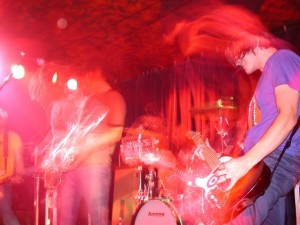
I first heard Shiner in 1997 via a mix tape containing “Fetch a Switch” and “The Situationist,” the best songs from their first two records, 1995’s Splay and the recently released Lula Divinia. I consulted Parasol Records’ catalog description to make sure my ears weren’t deceiving me—“Hum meets Jawbox,” yes, please—and promptly ordered Lula. Instantly a fan, I eagerly picked up their Sub Pop 7” for “Sleep It Off” b/w “Half Empty” and proudly wore a “SHINER” mock-Army t-shirt in high school. Absolutely none of my classmates understood it.
That changed when I left for college Champaign, IL, in 1999. The Midwest was Shiner’s literal stomping ground; they toured constantly and left ears ringing in their wake. Yet it’s still shocking to me that I’d get to see a non-local band eleven times in four years, even if it involved going to five other cities in the Midwest. Appropriately enough, only Allen Epley’s post-Shiner band The Life and Times matches that total.
That tie is about to be broken, however, since Shiner has reunited for five shows this summer in honor of an impending vinyl pressing of their 2001 swan song, The Egg. The concerts are slated for each member’s respective home city: New York, Chicago (x2), Kansas City, and Los Angeles, and you’re damn right I’m driving down to New York for my twelfth Shiner show.
In honor of this occasion, I’ve decided to do two things. First, if you haven’t heard Lula Divinia or The Egg, I’ll do you a favor and tell you to stop reading and buy them immediately. The combination of supreme heft, math-rock-inclined arrangements, and sneaky melodies is a gift that keeps giving. Second, I’m going to look back at each of the eleven previous times I saw Shiner. I’ll drag out photos, recall the accompanying acts (many of whom were legitimately great on their own accord), and do my best to remember the actual sets.
1/28/2000 at the Rocketbar in St. Louis, MO
I scored a ride from Champaign down to St. Louis because Centaur, Matt Talbott’s post-Hum band, was booked for its second-ever show there. I rolled with a lot of Hum fanatics at the time, and three of us had just seen Centaur play its first-ever show at a VFW in Danville, IL, a hangdog affair in which band members confused their then-numbered songs in front of some completely oblivious locals. This time, my friend Jackie and I were considerably more excited to see Shiner.
Autosleeper was first on the bill. The band name is presumably a reference to the Chapterhouse song title, but I remember thinking they were a pale imitation of both Shiner and Hum, not Midwestern-gaze.
Centaur’s sheepish emergence into the world continued. I have three distinct memories of their performance: Matt Talbott’s comically large beer bottle being at odds with their otherwise stoic stage presence; what would eventually become “The Same Place” comprising the best eight minutes of the set; and Talbott’s wah pedal breaking two songs in, to which he sighed “My band’s in this pedal.” Their performance sputtered out after one more song, proving Talbott’s assertion that his pedal truly was indispensible.
Shiner took the stage as a four-piece with Jason Gerken on drums and Josh Newton on second guitar, a new line-up for the group, not that I’d seen the others. Gerken had taken over for much-heralded Tim Dow, who’d moved to Los Angeles (where he’d collaborate with Failure’s Ken Andrews in both On and Year of the Rabbit). Newton replaced Joel Hamilton, who’d appeared on “Sailor’s Fate,” the solid b-side to their stellar 1999 single “Semper Fi.” True to Shiner form, both members had served time in Kansas City’s Season to Risk, but Gerken was more known for Molly McGuire, Newton better associated with Glazed Baby.
I was impressed by early versions of songs that would end up on Starless, especially “Unglued” and “Lazy Eye” (which sounded more eerie and threatening than it would on the album), but most of my memories from that night were of Gerken’s appearance and performance. He went shirtless with overalls—not a look I could pull off—and played with a swagger that he’d later tone down. I was borderline terrified of him.
9/28/2000 at the Metro in Chicago, IL
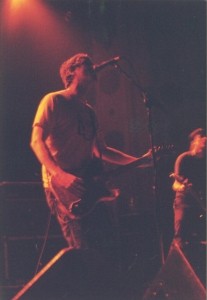
I celebrated the night before my 20th birthday with a trip up to Chicago for the dude-rockingest night of the Flower Booking Festival. In hindsight, I should have attended all of the nights: Trans Am, Don Caballero, Tortoise, The Sea & Cake, Grifters, Turing Machine, etc., but come on, Burning Airlines and Shiner? That’s the one I’m attending.
Bluetip started off the evening as no slouch of an opening act. I’d only heard the Hot (-) Fast (+) Union EP at the time, but I enjoyed it, especially “Compliment the Negative.” Did I immediately pick up the rest of their back catalog? Of course not. I regret this inaction. They were solid live and I never got to see them again.
Shiner was second on the bill, which meant they played a shorter set than I would have preferred. It was good hearing the Starless songs after the record came out—the title track was considerably better live. I recall “Fetch a Switch” making a welcome appearance.
The recently formed Hey Mercedes (75% of Braid) was third. I’d seen them in Champaign with Rectangle a few weeks earlier and learned a valuable lesson about the diminishing returns of early Hey Mercedes shows. The first song: “Whoa, this is great! It’s catchier than Braid!” Third song: “Still good! Still catchy!” Fifth song: Looks at watch. Seventh song: “How many more dunna-nuh, dunna-dunnas do they have in them?” In short, they didn’t have forty minutes of varied material yet and by the end of their set I was exhausted. I enjoyed their shows more once they had a full LP out, but as it turned out, “Bells” and “The House Shook” from that first EP remain my two favorite Hey Mercedes songs.
I’d seen Burning Airlines the previous October at the Highdive in Champaign, but this time they had a bunch of new material that was being road-tested before appearing on Identikit. Hearing “A Song With No Words” for the first time that evening was phenomenal. I wish I could watch J. Robbins play guitar every night, but sadly, he has other things to do.
I am fairly sure The Promise Ring were the evening’s special guest, but sticking around for another band after Burning Airlines felt sacrilegious to me. I did see The Promise Ring three other times in college, two of which were enjoyable sets highlighted by Davey Von Bohlen’s deft handling of hecklers, the last a baffling pre-Wood/Water set that trading their pop-punk enthusiasm for alt-country slogs.
1/20/2001 at the Highdive, Champaign, IL
Perhaps owing to the fact that I didn’t have to drive to a different city to attend the show, I can’t remember many of the details about this show. Centaur had certainly improved—their songs likely had names, not numbers by this point—and drummer Jim Kelly and bassist Derek Niedringhaus were holding down the fort. It was still a year before In Streams would come out. Will it ever get a follow-up? Who knows. They played unreleased songs at later shows, but even those concerts were way back in 2004 and 2005.
As for Shiner, I wish I had the set list for this show, since I’m curious whether they’d started to play songs from The Egg yet. My gut says no, but there are YouTube clips from a show at the Bottleneck in Kansas City from 2/3/2001 for “Surgery,” “The Simple Truth,” “Spook the Herd” (vastly different lyrics), “Bells and Whistles,” and “The Truth about Cows.” My guess is that they chose to debut the new material at the hometown show.
5/11/2001 at the Galaxy in St. Louis, MO
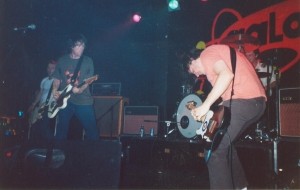
With the finals of my sophomore year of college in the rearview, my then-girlfriend, now-wife (henceforth TGNW) and I drove down to St. Louis to hang out with my friend Jon Mount and see Shiner for the fourth time. Given the fact that Riddle of Steel’s bassist ran the Rocketbar, I was surprised that the show wasn’t over there.
Both opening acts were bands that my peers generally appreciated more than I did. Riddle of Steel combined Midwestern indie rock with a larger dose of hard rock. If I lived in St. Louis, I likely would have seen them countless times, but they didn’t play Champaign much.
Houston had the Copper Press (the print magazine I occasionally contributed to, including a piece on Shiner) stamp of approval, since editor Steve Brydges snapped them up for his label, 54 40 or Fight, but I couldn’t get into them for one simple reason: their live guitar tone. It evoked a thinner, more metallic version of the guitar tones of Failure’s Comfort, which was like nails on a chalkboard for me. That’s a damn shame, since I otherwise liked their songwriting. (The cover art for Bottom of the Curve is inexcusably terrible, though.) I saw Houston three other times: their best performance came on a bill with Ring, Cicada at the Prairie House in Bloomington, IL.
One between-song comment to Jon Mount stands out about this show. After Shiner played “The Situationist” near the end of their set, I said “They definitely know which songs are their best,” to which he agreed. I’ve seen bands that play everything but the three or four best songs in their catalog, which is infuriating, but Allen Epley’s bands have never suffered from that issue.
8/11/2001 at the Southgate House in Newport, KY
If I had to rank my favorite all-time shows—a simple dare would get this project started—this one would be up there. I got to leave early from a family get-together for my TGNW’s family, which alone was cause for celebration, and cross from Cincinnati over to Newport, Kentucky for the show. The Southgate House was a great venue, like someone stuck a less claustrophobic version of the Middle East Downstairs into the back of a huge house. And the bill was, for my tastes, comparable to the Flower Booking night.
I was introduced to Spain’s Aina from a split 7” with The Capitol City Dusters in 1999. Aina’s contribution, “Lutton Can Wait,” is one of my most-played sides of vinyl, to the point where I had to buy a second copy of the record. Their sound is as easy to describe as it is to appreciate: the DC rock of Jawbox and Fugazi cut with the hard rock of AC/DC. Even with my fondness for “Lutton Can Wait,” I didn’t expect them to be this good. When a massive thunderstorm opened up outside midway through their set, singer/guitarist Artur Estrada pointed up at the lightning strikes and the band hit another gear. If you missed out on them, put their 1998 self-titled LP and 2001’s Bipartite on your to-buy list and check out Artur Estrada’s next band, Nueva Vulcano.
This is what I remember about Shiner’s set: “Holy shit, ‘The Egg’ and ‘The Simple Truth’ are insanely good.” The former might be Jason Gerken’s answer to Tim Dow’s work on “My Life as a Housewife,” whereas the latter pulled in some post-rock influence to excellent effect.
I could have gone home ecstatic after Aina and Shiner, but Burning Airlines was the icing on the cake. They played a solid, Identikit-heavy set. I remember talking to drummer Pete Moffett at the show, but damned if I recall what we chatted about. I got to see them one final time in Champaign the next month on another solid bill (Rival Schools and Hey Mercedes), but J. Robbins’ days of heavy touring were soon coming to a close. Am I still bummed Jawbox didn’t do any proper reunion shows for the For Your Own Special Sweetheart reissue? Yes, yes I am.
10/19/2001 at the Metro in Chicago, IL
In one of the weirder bills in my concert-going history, Shiner took the middle slot between two Barsuk bands, piano rockers The Prom and the rapidly ascending Death Cab for Cutie. In one sense, Shiner and Death Cab sharing a bill makes sense, since Death Cab toured with Shiner’s DeSoto Records label-mates The Dismemberment Plan and briefly shared bassist Nick Harmer with another beloved DeSoto band, Juno. But despite the mutual fondness for both bands between my TGNW and me, bridging the gap between air-drumming dude-rockers and a sensitive emo kids was a tall order.
There was no doubt which side of that ledger The Prom fell on. Imagine Ben Folds Five’s “Brick” as an early 2000s emo song and you’re 85% of the way there. Fortunately, my now-wife didn’t care for them, so I avoided having to buy that CD and hear it a few times. Phew.
My desire to hear songs from Shiner’s forthcoming The Egg again was bordering on a bodily need. It’s different now that you can see videos of unreleased songs on YouTube before they’re recorded, but in 2001, the only way I could wrap my head around “The Simple Truth” and “The Egg” was to see Shiner perform them as much as possible. It was a rare situation even then—most bands don’t tour heavily before their new album comes out, but Shiner was an exception to that rule. I’m endlessly thankful that they were.
The album was three days away from its release, but by this point “The Simple Truth” and “The Egg” were the standouts of their set. I reveled in the fact a number of Death Cab fans around me were plugging their fingers into their ears and grimacing.
I remember talking to Josh Newton at this show and asking him how their dates with Death Cab were going. He relayed a story from one of the previous nights, in which he was in the back of the club playing Golden Tee during their set, and the song approached silence. Naturally, Golden Tee made a ton of noise and a good percentage of the audience turned around and glared at him.
The members of Death Cab for Cutie, however, had a better sense of humor. Their amps had DC/FC stylized in the AC/DC font, so naturally I yelled out for AC/DC songs. They laughed, but sadly didn’t break out a rendition of “Big Balls.” I couldn’t help but feel the letdown after Shiner, however, since Death Cab’s set was quieter than the one they’d played at the sweaty Fireside Bowl nine months earlier (before The Photo Album increased their hype considerably) and couldn’t help but feel like an elongated, post-coital cuddle session.
One more note: we also managed to see Rectangle and Danger Adventure at The Big Horse, a Mexican restaurant/music venue. It was the only time I saw Rectangle outside of Urbana-Champaign, but the sound was so terrible that I probably only heard half of them.
10/20/2001 at the Highdive in Champaign, IL
There aren’t many bands I’ve seen on back-to-back nights, but Shiner joined the club when they headed down to Champaign to play The Egg in its entirety. That gimmick isn’t necessarily my favorite—I like guessing which song’s coming up next—but it worked for Shiner, since The Egg is an album in the way some decrepit Rolling Stone critic might someday elucidate. Plus they weren’t doing it as a way to milk dutiful fans out of another $40 (cough, Pixies, cough).
Not that I needed more reason to attend, but finally getting to see Collinsville, Illinois, instrumental rockers, Ring, Cicada as the lone openers for this show, but waiting is appropriate for the band. Having existed in some form or another since the mid ’90s, Ring, Cicada didn’t release a proper LP until 2003’s Good Morning, Mr. Good, which was sadly overlooked. They had a few short run EPs before the LP, but nothing that extended past regional affection. Naturally, all of my friends who had seen then raved about their performances, and rightly so: Ring, Cicada played an unusually emotional brand of math-rock. I remember being floored by their guitar tones, which were the direct opposite of Houston’s Achilles heel. I could throw a bunch of tired adjectives at you—warm, full-bodied, rich—but they wouldn’t tell the whole story. Guitarist Christian Powell emerged as an occasional vocalist on Good Morning, but the instrumental takes were hardly deficient.
Two key Shiner connections: first, bassist Eric Abert has been in The Life and Times since 2005, second, Ring, Cicada is on the bill for the Shiner reunion show at the Bottom Lounge, which makes me sad I’m no longer within driving range of Chicago.
4/6/2002 at the Highdive in Champaign, IL
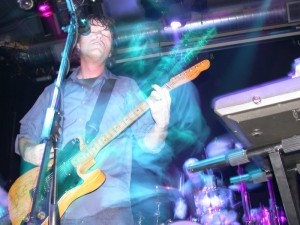
I’d come back from a road trip to Louisville, Kentucky the day before, glowing from a dominating triple bill of Fugazi, Shipping News, and Rachel’s (RIP Jason Noble), and was thrilled to see Shiner as well. While the Flower Booking and Southgate House bills were better, this evening might rank as my favorite Shiner performance.
The only opener was Schatzi, who bridged the gap between indie rock, emo, and pop-punk. Super enthusiastic and melodically driven, like a cross between Superchunk and The Get-Up Kids. I thought of them last year when I heard Hammer No More the Fingers’ Black Shark; it’s similarly catchy, but HMNTF's songs stuck with me, whereas I forgot about Schatzi’s songs by the end of the night.
Feel free to blame Shiner’s set for my Schatzi amnesia. They played both of the Japanese bonus tracks from The Egg, “Dirty Jazz” and “I’ll Leave Without You,” which were great live. They continued to play the best songs from The Egg, along with the highlights from earlier records. Perhaps the most obvious reason for me to think of this show more than the others is that I have a 24x18” blow-up of the accompanying photo above my desk.
I took it with my new Nikon digital camera, which I was still learning how to use. Results were mixed, but since Shiner didn’t shy away from lights, I could do my flash-and-long-exposure technique to get either motion or ghost images. That particular photo is the best ghost image I’ve ever taken—Epley looks like he’s conjuring a raging spirit. If I had steadier hands, maybe Gerken’s kit wouldn’t look like a neon smear.
7/3/2002 at Radio Radio in Indianapolis, IN
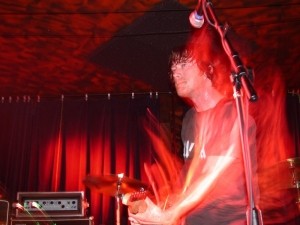
I’ve mentioned my TGNW a few times, but I have to give her credit: When I’d have the crazy idea to drive out to Indianapolis to see Shiner the night before the Fourth of July, she gladly tagged along. And this show was in the pre-Yelp days, so I literally knew nothing else to do in Indianapolis. If it wasn’t on the block of the club, I didn’t know about it. I guarantee we ate dinner at some shitty pizza joint. That was the golden age for shitty pizza joints.
New York City’s Pilot to Gunner was the first act on the bill. I’d heard their Hit the Ground and Hum EP when it came out, since its press release named the right names (Jawbox, Mission of Burma), but wasn’t impressed. The day of the show I decided to check out their new full length, Games at High Speed, on eMusic, and was stunned by how much they’d improved. Their high-energy post-punk shout-alongs were even better live. I chatted with them after their set and learned they’d just played the Prairie House in Bloomington, IL, and one of them sheepishly admitted to making out with Nudie, a frequent visitor to the Prairie House. Nudie, as you might imagine, had a tendency to get naked (along with one of house’s residents) in the routine after-show dance parties. More importantly, Nudie had a tattoo on her inner thigh: an arrow pointing crotchward with “Tasty” written nearby. Regardless of their beer goggles, I still enjoy Pilot to Gunner a great deal, and am glad they’re finally following up 2004’s Get Saved with the upcoming Guilty Guilty on Arctic Rodeo Records (the same label that’s issuing Burning Airlines’ two albums on vinyl).
Shiner’s set was looser than the past few—they weren’t promoting The Egg as hard and they were in the middle slot on the bill, so they skipped around their albums a bit more. As much as I loved hearing songs from The Egg the previous summer, it was nice to get more from Lula again.
Jets to Brazil closed out the show. Is it slander to admit that I was never obsessed with Jawbreaker or Jets to Brazil? Probably just lost a bunch of cred points. I do enjoy Orange Rhyming Dictionary, especially “Chinatown” (along with a few Jawbreaker albums), but when it came down to Jawbox/Burning Airlines vs. Jawbreaker/Jets to Brazil in the non-existent battle of the similarly named bands, I’m a J. Robbins guy all the way.
11/11/2002 at The Highdive in Champaign, IL
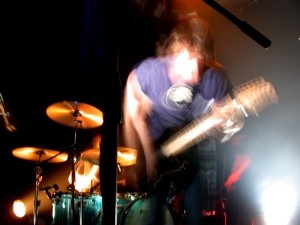
I doubt that I saw any of The Capitol City Dusters’ set and here’s why: I had a long interview with Aina drummer Pau Santesmasses, who had the best command of English in the group, and planned to work it into a piece for Copper Press. But I assume that my finals kept me from working on it, and the interview—which I remember being quite insightful to their fondness for DC music—sat on a microcassette, untouched. It’s probably still in a bin in my basement. I feel genuinely shitty about it.
Aina, of course, were excellent, just like they’d been the year before. By this point I’d been able to process their records, so the shock and awe of the Southgate House performance had worn off, but their command of the material hadn't. I gladly would have seen them another nine times, but they broke up after a pair of EPs.
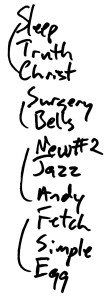
I only have one Shiner set list in my possession and it’s from this show. Do I remember what “New #2” was? Sadly not. Otherwise, the song selection is flawless. “Sleep It Off” from the Sub Pop single has always been one of my favorites, and I don’t recall them playing it too often.
One note: I believe this was the show when Paul Malinowski said something like “I see you at a lot of these shows” to me. Yes, yes you did.
1/25/2003 at the Madrid Theater in Kansas City, MO
When Shiner announced in late 2002 that they were breaking up, I wasn’t hugely surprised. That may be strange for an obsessive fan to admit, but what drove Shiner was Allen Epley’s desire to improve the band. That’s what he did with the three-piece version on Lula Divinia vs. Splay, that’s what he did with the four-piece version on The Egg vs. Starless. In some ways, Shiner wrote themselves into a corner with The Egg; there was no inferior band member to replace, no obvious flaw to correct. The clearest course was to do something different, which was easier to do with a new band name and new collaborators. Epley’s too committed to music to quit entirely, so I knew he wasn’t going to disappear into a day job, and sure enough, he emerged a shortly after with The Life and Times.
That isn’t to say that I wasn’t disappointed that Shiner was breaking up, since I wouldn’t get to see those songs live again (for a decade, at least). As such, there was no way in hell I’d miss out on their final show. It’s the longest I’ve driven for a concert—although I admittedly flew from Boston to Seattle for Juno’s reunion shows—and I’m eternally grateful that Jackie, Jon, and Bill joined me for the adventure. It’s entirely possible I might have died on the drive back to St. Louis if not for the gentle nudge that I should stop and walk around.
I remember very little about opening act Elevator Division—they were the local opener without the local sound, and given the number of Kansas City bands I’ve enjoyed over the years, that felt like an intrusion on a proper send-off. In comparison, Shiner’s common touring partner Houston was a good fit, irritating guitar tone be damned.
The last opening act was considerably more exciting. Dirtnap was/is a Kansas City band who’d released two excellent records (the still-weird combination of atmospheric Slint post-rock and aggressive Midwestern rock of 1997’s Below the Speed of Sound and the emotional resonance and superlative guitar work of 2003’s Long Songs for Short Term Friends), but hadn’t ventured out to Champaign during my time there. They apparently played a show in Kansas City back in April, which fortunately made it up to YouTube. Excuse me while I watch all of it.
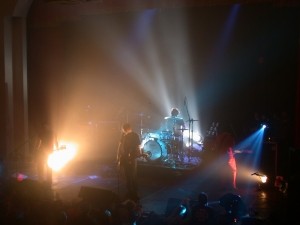
Shiner’s final performance was a blowout in the best possible way. They played 24 songs in a nearly two-hour-long set. Thax Douglas, poet laureate of rock shows in Chicago, came out to do a reading. They played songs I hadn’t heard them do in ages (“Released,” “Sideways”/“Pinned”). The encore started with the Splay lineup of Epley, Dow, and bassist Shawn Sherrill performing “Brooks,” then swapped Sherrill for Malinowski to do Lula material, including Dow’s drumming clinic “My Life as a Housewife.” (Fun fact: Gerken wouldn’t do “Housewife” because Dow owned it so much.) Watching Dow drum was a thrill—he’s a much smaller guy than Gerken, but still hits with such power and precision. Newton and Gerken reemerged for the last few songs, closing the night with “Starless.” It was an appropriately somber closing note, reminding everybody that yes, they’re done.
(Until the reunion shows, of course.)
You can download their final set here. Thanks to whoever originally recorded and dispersed it. I believe Shiner is still planning on releasing a retrospective DVD, which may contain some or all of this set.
|
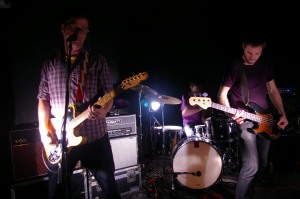
I don’t have any Deadhead days in my past, so my history of seeing the same band multiple nights in a row in different cities is limited to DeSoto Records acts: the Dismemberment Plan (11/11/99 in Chicago, 11/12/99 in Champaign), Juno (8/23/01 in Champaign, 8/24 in St. Louis, both with Ted Leo), and Shiner (10/19/01 in Chicago, 10/20/01 in Champaign). This weekend I added a fourth former DeSoto group to the list when I caught The Life and Times at O’Brien’s Pub in Allston, MA, on Friday and The Loft in Poughkeepsie, NY, on Saturday. They were finishing up a week-long East Coast tour in advance of their 2012 LP No One Loves You Like I Do.
The lineup for the Allston show started with Tired Old Bones, a local four-piece who make distorted garage rock with alt-country and blues overtones. Vocalist/organist Bridget Nault supplies the make-or-break elements in her emphatic delivery and rangy Hammond leads, and for the most part, I leaned “make” over “break.” (Never drifting into Doors territory helped their case.) They have one 7” under their belts—the exquisitely packaged “Country Circus” b/w “Do Not Disturb”—and hearing those songs on BandCamp offers the differentiation between the guitar and bass parts that wasn’t always present in the live mix.
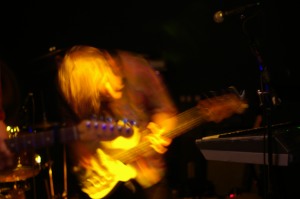
Mirroring the excellent 2009 billing that first introduced me to the group, Deleted Scenes hit the stage before The Life and Times. The DC band’s DNA features both the post-punk of the Dismemberment Plan and Medications and a healthy dose of lush indie pop. The difference between their recorded material and their live performances has been the balance of these sides. Last time the absorbing performances of Birdseed Shirt material like “Mortal Sin” and “Turn to Sand” made their recorded counterparts sound muted. The recently released Young People’s Church of the Air is a superior album that uses its production tricks to amplify what’s going on in the songs rather than deflect their effects. They still turn up the DC knob with more immediate live renditions of “Baltika 9” (video), “What an Awesome Backhanded Compliment,” and personal favorite “English as a Second Language” (live video), but the gap between record and stage is less of a pale imitation and more of a complementary experience. I’ll say more about Young People’s Church of the Air sometime soon; ordering your own copy will allow you to play along at home when I do.
Skipping ahead to cover the other acts on the Poughkeepsie bill, I got there in time to catch local trio Winterlong, who are apparently unaware of the Swedish power metal group of the same name or not afraid of them. The Poughkeepsie version is a mix of heavy rock, ’90s emo (the Mineral kind, not the Get-Up Kids variety), and math-rock with dual vocals, heavy guitars, and extended jams. Their heart’s in the right place, but everything needs to be tightened up: shorter jams, clearer vocal melodies, etc. Worth keeping in mind for when their record eventually comes out. You can hear a few songs: "Queen Elizabeth III" and "Fishnet."
Fellow locals Take One Car closed out the Poughkeepsie show, bringing a blend of atmospheric post-hardcore that brought to mind At the Drive-In playing a set with Mars Volta’s pedal boards. Sure enough, Take One Car did a cover set of At the Drive-In songs last year. I did appreciate the balance between screamo vocals and digital delayed instrumental passages—they never drifted too long or wore out their energy.
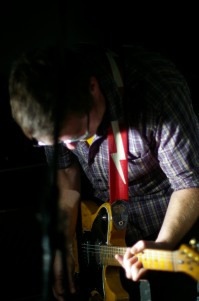
These two shows marked the ninth and tenth times I’ve seen The Life and Times live, putting me one away from matching the times I caught Shiner. When I think back to those Shiner sets, my favorite were in the spring and summer of 2001 when they debuted material from the forthcoming The Egg. Nothing against the recorded versions of “The Egg” and “The Simple Truth,” but getting to know those songs live through Shiner’s militant touring schedule was a true treat. The Life and Times’ upcoming third LP, No One Loves You Like I Do, is due 1/17/2012 on SlimStyle, a new music imprint from Comedy Central, and these two shows made those months even harder to endure.
In addition to cuts from Tragic Boogie (“Let It Eat,” “Old Souls,” and an impressive rendition of “Pain Don’t Hurt”), The Magician EP (“The Sound of the Ground” in Allston), and Suburban Hymns (“My Last Hostage,” “Running Redlights”), The Life and Times trotted out at least four new songs over the course of the two shows. “Day IX” (live video) was my favorite, driven by Eric Abert’s nasty bass line and a strong vocal melody from Allen Epley. “Day II” (live video), which appeared on the group’s 7” from earlier this year, stretches out live and gains considerable muscle mass. “Day I” (live video) might be most melodic of the batch, at least until it hits its spiraling conclusion. They played one more new song at the Allston show, “Day XII.”
Key changes in The Life and Times since Tragic Boogie help structure and color the new material. Rob Smith of Traindodge and Roma 79 joined up on keyboards and second guitar, a move that adds depth to the songs and also frees up Eric Abert to focus on muscular bass lines instead of multitasking to flesh out the mix. Epley and Abert are now located in Chicago, which means that No One Loves You Like I Do was written and recorded during trips down to Matt Talbott’s Earth Analog studio rather than in Epley’s old home studio. Judging from these songs, I predict No One Loves You Like I Do will trade some of Tragic Boogie’s painstaking overdubs for more chiseled arrangements. If “Day IX” is any indication, I am all for this new direction.
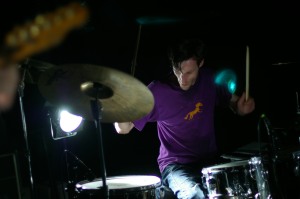
One thing I haven’t stressed is how impossibly loud The Life and Times were at O’Brien’s Pub on Friday. I’m used to having butterflies in my stomach from those Shiner shows, but I can’t recall a set where ear plugs were no match for the wall of sound coming at me. If you want to clear out your sinuses, see a normally loud band on the pocket-shaped stage of O’Brien’s.
The Life and Times will tour again next year once No One Loves You Like I Do, and I’m waiting with bated breath for both the album and a fresh set of east coast dates. They only have two booked at the moment: an opening slot for Hum’s sold-out reunion show in Kansas City in October and a killer bill with J. Robbins’ Office of Future Plans in Chicago in December, so if you’re in, near, or aware of those cities (and can shiv someone for tickets to the Hum gig), go see them. In the meantime, remember to grab “Day II” b/w “Day III” and a copy of Deleted Scenes’ excellent Young People’s Church of the Air.
|
|
There’s comedic potential to three New York City-based bands making the drive up 95 to play a show at the Brighton Music Hall in Allston, but from what I could tell, the groups did not cram into a single van, mock Red Sox fans for the team’s recent slide, or bring enough thin-crust pizza for the entire audience. Instead, we got the bummed-out club music of Beige, the hodge-podge of contemporary synth-pop and retro styles from Hooray for Earth, and the melodic indie rock of Cymbals Eat Guitars in a reasonable compromise.
Words of advice for opening act Beige: Change your band name. This was your first show outside of New York City and you haven’t released any official recordings, so it’s not too late. If you need further encouragement, perhaps the YouTube presence of Beiges from Malta and Hamburg will make you reconsider this terrible decision. Maybe your peers in Brooklyn are all supportive of your chosen title, but I am doing you the solid of saying that the vast majority of critics will not be so generous. Your band name is an unnecessary hurdle, an invitation to either tune you out or chew you out. Would you name your first album Forgettable at Best, Future Coaster, or Poor, Even in This Economy? Why am I asking that, of course you would—you named your band Beige. Unless you’re war criminals hiding from the public eye, there’s no logical reason to sabotage your music with this name. If you’d named your band almost anything else, I would have spent this paragraph talking about your actual music, like how the combination of throbbing beats, delay-heavy keyboard and guitars, and muffled vocals made for some intriguingly sad club music. I would have compared you fondly to early Accelera Deck, you know, before Chris Jeely fell in love with glitch. I would have made substantial comments about the promise of your band. But alas, you named your band Beige.
Deep breath, buddy. Deep breath. Onto the next act.
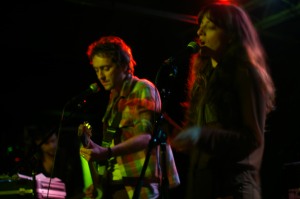
Hooray for Earth started out as a Boston band in 2005, but changed zip codes when songwriter Noel Heroux moved to New York in 2007 to join his girlfriend, Jessica Zambri (whose own band, the appropriately named Zambri, also features her sister). The project was essentially on hold until 2009, however, when the original drummer was replaced by Joseph Ciampini and the group started recording again, producing the 2010 Momo EP and this year’s True Loves LP. All of this background information is pertinent—the group echoes the trends coming out of Williamsburg, Zambri’s background vocals are prominent on record and live, Ciampini’s drumming is a welcome departure from programmed loops, and that distant, perhaps forgotten history shows its face from time to time. Their sound hits on three major buttons: reverb-draped synth-pop, ’80s party rock, and ’90s alternative. Given my rockist tendencies, the ’90s alternative side had potential, but it fell oddly flat. Zambri wandered off stage for those songs, leaving behind a traditional three-piece rock group that I suspect will be ushered out as new material accumulates. The ’80s party rock fared better—“Sails” splits the difference between Duran Duran and MGMT—but plays more to Zambri’s strengths as a vocalist than Heroux’s. Hooray for Earth excelled with the current-sounding synth-pop, namely “True Loves” and the set-closing “Black Trees.” That’s where the value of Ciampini as a live drummer was most obvious: substitute in a drum machine and those songs float away completely. There may be a surplus of Brooklyn bands mining the retro-modern ache of “Black Trees” (collaborators Twin Shadow, for one), but if Hooray for Earth follows that path on their next album—and records it as soon as humanly possible—they will headline their next tour.
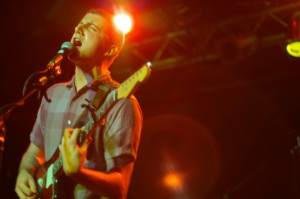
Tuesday’s headliners Cymbals Eat Guitars (Flickr set here) have come into their own this year on their sophomore album, Lenses Alien, released digitally through Barsuk in August. Its predecessor, 2009’s Why There Are Mountains, arrived with on-point comparisons to Pavement, Pixies, Built to Spill, Modest Mouse, and Sonic Youth, but Lenses Alien pays off those debts with a stronger, more confident sense of self. Guitarist/vocalist Joseph D’Agostino’s lyrics carve elliptical paths through oblique poetry, coming closer to Tim Kinsella of Joan of Arc / Owls than the aforementioned acts. These lyrics prove difficult to parse live, but every other detail of Lenses Alien translates: D’Agostino’s melodic delivery, backing vocals from bassist Matt Whipple, and busy piano/keyboard and wispy noise from keyboardist Brian Hamilton.
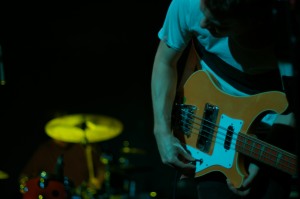
The highlight and litmus test of Cymbals Eat Guitars’ set is “Rifle Eyesight (Proper Name),” Lenses Alien’s epic eight-and-a-half minute opener and one of the year’s best rock songs. The strains of ’90s indie rock feature some of the group’s catchiest hooks, but the song excels when those strains fall apart like a late ’90s Lee Ranaldo composition. (There’s nothing wrong with cribbing notes from Sonic Youth when they’re the right notes.) Those noise passages may have thinned out the crowd, but D’Agostino and Hamilton were openly joyous as they tweaked pedals and harnessed feedback.
Cymbals Eat Guitars didn’t bother stepping off stage before playing their encore, Lenses Alien’s excellent closer “Gary Condit.” Joseph D’Agostino apologized that physical copies of their new album aren’t yet available, then bolted to the merch table to sell shirts and talk to fans. It was an outright endearing end to the evening, even if it meant that I have to wait until October 11 for a vinyl copy of Lenses Alien. Don't let that stop you from catching them on this tour.
|
|
Last night at Great Scott I was presented with an impossibly rare occurrence for a jaded concert-goer: a four-band set where I was not just willing, but actually excited to see all four bands. How often does that happen? The last instance I can think of was the opening night of the Flower Booking Festival at the Metro in Chicago, where Burning Airlines, Hey Mercedes, Shiner, and Bluetip brought an epic amount of rock. And that was a special occasion. And eleven years ago. But much like that show, the four bands at Great Scott played different, but complimentary styles.
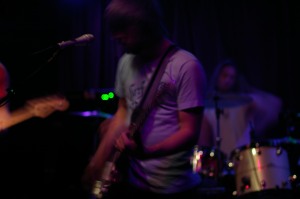
The newly expanded Me You Us Them arrived as a four-piece, with former drummer Jimi Jano rejoining the group as a keyboardist/auxiliary drummer. The change adds depth to their more shoegaze-oriented tracks, represented in their set by “Drugs” and a pair of new songs, and melody and noise to their more aggressive songs (“As of Now” and “iQuit”). It also unleashes drummer Zach Eichenhorn from the tyranny of the click track which accompanied their old backing loops. (Fun fact: Eichenhorn also drums for the instrumental rock band Adam’s Castle, whom I saw in Urbana, IL, back in 2003.) Me You Us Them closed off their set with a nasty take on “Research” (live footage) from their split single with Bloody Knives and the double-drummer ache of “Loving Like Lawyers” (live footage), the highlight of their 2010 LP Post-Data. Here’s hoping the new line-up tours a lot and records those new songs soon.
Fellow Brooklynites Grandfather played second, bringing a confrontational mixture of the aggressive rock of Shellac, the Jesus Lizard, and June of 44, and the art-rock twists of US Maple, Shudder to Think, and Singer. The resulting post-punk concoction swerves between vulnerability and violence, confidence and curiosity as it winds through bracingly intense passages. Their Steve Albini-recorded 2010 LP Why I’d Try is available for free download, but I gladly picked up a copy on vinyl.
After listening to Grass Is Green’s Yeddo and Chibimoon for much of the last week, I appreciated hearing the best of those songs live delivered with kinetic energy and precision. “Slow Machine” was the highlight, its multi-part construction sounding particularly epic. They closed out their set with the hyperactive “Uhm Tsk,” which reminded me of the early, crazy days of the Dismemberment Plan. (No trombone, however.) It was also a special treat to hear Smart Went Crazy’s Con Art as the house music once their set had finished.
Pile closed out the night, sounding downright loose and raw after the tightly wound math-rock of Grass Is Green. Bits of hardcore adrenaline, country finger-picking, and garage rock energy were all filtered through Rick Maguire’s charismatic vocals. What I appreciated most was the unpredictability: they’d get a head of steam, then cut it off and hit a lull; threaten a set-ending jam and then stop the song entirely; turn a howl into a sheepish grin. I grabbed a copy of Pile’s new 7”, “Big Web” + 2, which you can hear and order over at Bandcamp. They’re heading out to the Midwest this month, so catch them if they’re in your area.
There’s an encore performance of this billing at the Cameo Gallery in New York tonight, and it’s awfully tempting to blow off my plans and see the four bands again.
|
|
Between the ungainly 5:30pm doors at the Royale and the considerable excitement over the sold-out Guided by Voices show across town at the Paradise, both Les Savy Fav and local openers Bodega Girls had their work cut out for themselves on Friday night. The Royale has a stop-dead time of 9:30pm for these weekend shows, which is earlier than some shows start. Neither group is designed as a measured warm-up for more serious clubbing later in the evening; between Bodega Girls’ dance-party beats and Les Savy Fav’s notoriously sweaty audience invasion, this bill should cap off an exhausting evening, not act as a prelude.
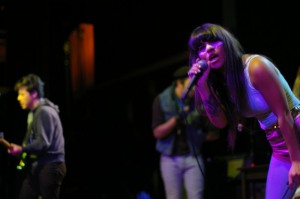
A self-professed party band, Bodega Girls tried their damndest to steer the slowly swelling crowd onto the dance floor, but didn’t quite set the Royale on fire. Their first few songs offered a grab bag of retro styles—old school ’80s rap, early ’90s R&B—but once their guitarist and bassist came on stage, the sound settled into laptop-beat variation on !!!’s insistent dance-rock. Songs about liking black guys and partying on school nights were built around white-guy rapping in the verses and big choruses reminiscent of hair metal. There’s a fine line between enthusiasm and irritation, however, and the primary MC’s trips through the audience and relentless demands for the audience to cut loose went too far past Jon Spencer’s baseline. (There are only so many rounds of applause the audience can give itself.) Bodega Girls will presumably release their debut LP sometime in the next year, hopefully after the songs have gained focus.
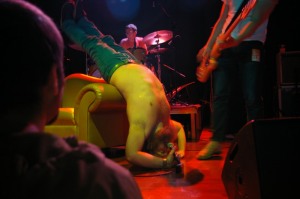
The difference in the stage presence of Bodega Girls and Les Savy Fav is simple: Tim Harrington will not be ignored. You can try to stand clear of the sweaty, shirtless Tasmanian devil, but odds are he’s going to find you. Once he finds you, he may steal your chewing gum, spray a cloud of beer above your head, try on your clothes, grind up against you, or let you scream the words to the current song into the mic. Any of those are possible, if not probable. Perhaps the most exciting part of seeing Les Savy Fav is spotting audience members who came entirely unprepared for this onslaught. The mixture of shock, enjoyment, and fear on their faces is both understandable and appropriate. Even if you enjoy Les Savy Fav on record, the live experience is a decidedly different beast—come prepared.
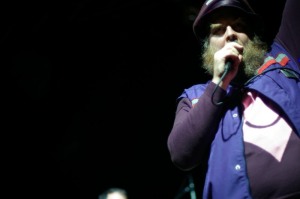
Harrington’s stage presence isn’t limited to sweaty audience participation. Recalling his MC duties for the comedy stage at this summer’s Pitchfork Festival, Harrington opened the show in costume, playing pipes and wearing a wig and hippie attire. The weird calm before the storm lasted an uncomfortably long few minutes before the group launched into “Appetites,” the Silver Jews-quoting lead song from this year’s Root for Ruin. Within its first 30 seconds, Harrington descended into the crowd, made a bee-line for the side wall of the posh Royale, and dragged a large leather sofa on stage. He then appropriated two hats and a vest from the audience, marking the evening’s first costume change, grinded against his first audience member, and stripped down to his Christmas-lights adorned chest. Soon enough, those Christmas lights came off, getting whipped around in circles before being cast aside.
Given the shock and awe of Harrington’s performance, you could easily forget that there are four other members of Les Savy Fav. Yet with Harrington off exploring the darkest corners of the Royale, the band held the fort quite well. Guitarists Seth Jabour and Andrew Reuland’s digital-delayed strafing is the group’s sonic signature, loading in enough muscular riffs to sending the mosh-happy crowd into fits of violent reverie. Their biggest challenge is maintaining energy while Harrington’s out of range or ad-libbing rambling monologues about wanting to lock the doors to the Royale and stay inside for two years or heralding the bros in the audience, one Jabour and company must know quite well in the band’s fifteenth year of existence.
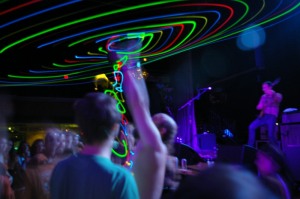
Harrington’s whirling dervish antics are more immediate, but Les Savy Fav imparted a more important lesson on its up-and-coming openers: you need memorable songs, too. In a set reliant on Root for Ruin’s melodic indie rock, past favorites ruled the evening: the bass-driven sing-along “Patty Lee,” the cathartic howls of “What Would Wolves Do,” the revving/idling engine “Rome,” and two chaos-inducing audience favorites, “The Sweat Descends” and “Who Rocks the Party.” It’s easy to view Les Savy Fav’s albums as distant seconds to the visceral danger of their live sets, but without them, the kids don’t know the words to scream along.
Les Savy Fav closed up shop around 9:15pm, leaving the Royale staff enough time to clean up from Harrington’s unique vision of interior design. On the way out, I saw a member of the night crowd coming in—short skirt, high heels, presumably some item in leopard print. A few words of advice: don’t slip on the sweat.
|
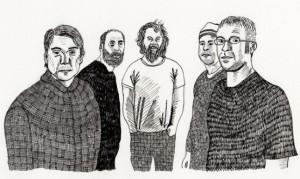
A few years ago I postulated that there are three potential favorite albums for Built to Spill fans, and each selection says something about your general musical taste. 1994’s There’s Nothing Wrong with Love is the logical choice for anyone leaning toward indie pop (which includes the majority of female Built to Spill fans I’ve met). The layered guitar epics of 1997’s Perfect From Now On are tailor-made for insular dudes like yours truly who prefer Doug Martsch as the new J. Mascis. Finally, 1999’s Keep It Like a Secret appeals to those searching for a middle ground between the earnest pop and the guitar heroism. While I have my obvious preference, they’re each highly recommended.
The rub for my theory is that Built to Spill has since recorded three more albums (and started out with Ultimate Alternative Wavers, but come on, don’t be a jerk). Is it possible that someone could choose Ancient Melodies of the Future as their favorite Built to Spill album? Certainly. Stranger things have happened. But if I start talking with someone and they reveal that Ancient Melodies is their favorite Built to Spill album, I may very well walk away before they continue to share their preferences for Pavement’s Terror Twilight, Polvo’s Shapes, and Seam’s The Pace Is Glacial. Unless that is the first (and possibly only) Built to Spill album they’ve heard, it is not a logical choice. You in Reverse and There Is No Enemy are improvements from Ancient Melodies, but I’m not going to wake up one day and prefer any of them to Perfect From Now On.
Here’s my million-dollar question: Which Built to Spill album is Doug Martsch’s favorite? It’s common practice for artists to say “The new album is our best!” because they’re so invested in the process. You can, however, tell how bands feel about their previous work in set lists, especially if they’re touring outside of the context of a just-released or upcoming album. Foals closed their show the night before with three songs from Antidotes. Pavement only played “Spit on a Stranger” from Terror Twilight when I saw them a few weeks back. Shiner almost always pulled out “Semper Fi” and “The Situationist.” Thursday’s Built to Spill show should have demonstrated a similar transparency for Martsch’s preferences on his own material, but I don’t know if I learned anything.
I didn’t write down their set list, but I can remember most of the early songs because I kept Googling them on my iPhone to confirm which of the last three albums they represented. “Traces” from You in Reverse started things off with some somber, mid-tempo guitar interplay. “Reasons” was instantly recognizable as a There’s Nothing Wrong with Love song, although not one of my favorites. The hummable yet slight “Strange” is, in fact, from Ancient Melodies. Martsch tipped off that the cover of Grateful Dead’s “Ripple” was a “non-original,” but its loping pace wasn’t far off from the rest of the set, especially the alt-country tinges of “Hindsight” from There Is No Enemy. “Twin Falls” was a welcome Love representative, short and sweet. “Else” broke the cherry for Keep It Like a Secret roughly 40 minutes into their set. By this point, the languid pace and questionable song selection kept my eyes glued to the running clock at the side of the stage.
There was a slight reward for my patience near the end of the set when “Time Trap” and “Carry the Zero” brought a very noticeable energy to both the band and the audience, but I couldn’t bring myself to stick around for the unearned encore. If I had, I would’ve seen “Car,” “Big Dipper,” and “Untrustable/Part 2 (About Someone Else)” (if this list is accurate). Damn? I left the Paradise knowing full well that Doug and company would bring some of his best songs out for the encore, but why make me wait? In a set low on energy, wouldn’t “Goin’ Against Your Mind” be an improvement on “Traces”? Wouldn’t “The Plan” give “Else” a jolt? Wouldn’t “Stop the Show” be welcome? Clearly there must be some reason for this mid-tempo snoozefest.
Here are my theories: 1. They saved the best songs for Friday’s second show at the Paradise. (Some of them, at least: “The Plan,” “Kicked It in the Sun,” even “The Weather.” Saturday’s show in Pawtucket looks like a dream, though.) 2. Doug Martsch likes all of his albums equally. 3. Touring without a new album feels too much like work. 4. Playing Perfect From Now On straight through on a tour two years ago took those songs out of rotation. 5. There isn’t much of a need to one-up the workmanlike indie rock of touring openers Revolt Revolt, friends from Boise. 6. His refusal to discuss his lyrics in interviews and instead only talk about the aesthetic choices or recording process implies a level of detachment from his most resonant material.
The sixth point (in particular) may sound harsh, but think about it: the issue with this show and Built to Spill’s last three albums is that Doug Martsch is that what makes the band great is being rationed. Martsch may be fine with that. It was easy to say what’s great about TNWWL, PFNO, and KILAS. The appeal of certain songs from the last three albums could be summarized so concisely, but none of them is consistently engaged both musically and lyrically.
Seeing streams of Chavez and Sonic Youth’s superb performances from Matador at 21 on Friday night put my disappointment with Built to Spill’s set into perspective. Chavez didn’t play “Wakeman’s Air”—perhaps my favorite of their songs—but every song they did play completely ruled. (Only having two LPs and an EP helps the selection process—sorry, “Little Twelvetoes” fans.) Sonic Youth made a more dramatic decision, playing only “Mote” and “Bull in the Heather” from their 1990s and 2000s albums, choosing instead to load up on classics from EVOL, Sister, and Daydream Nation, then close with “Death Valley ’69.” I could make a four-hour playlist of Sonic Youth songs I wouldn’t want to hear—most of their only Matador LP, The Eternal, for instance—but if I had to narrow them down to an hour-long block, their Friday set might very well have been it.
There’s a good reason why both Chavez and Sonic Youth killed on Friday night—it’s a hell of an occasion and any great band would best bring their a-game. Should I excuse Built to Spill for not having that occasion? That sense of occasion was present for the aforementioned Perfect From Now On coronation tour. They shared the bill with fellow legends in the Meat Puppets and Dinosaur Jr. They played PFNO, “Goin’ Against Your Mind,” and “Car.” I wanted to hear more, but I didn’t blame them for skipping “Carry the Zero.” This show, on the other hand, couldn’t end fast enough.
One final note: it’s even more baffling that this Built to Spill show was so staid when the band has just released a completely unexpected disc of synth-tastic versions of Built to Spill songs like “Goin’ Against Your Mind,” “Else,” and “I Would Hurt a Fly” under the pseudonym Electronic Anthology Project. I might have preferred seeing the band do a few of those versions!
|
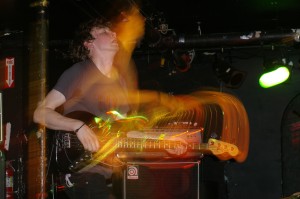
I’ve been meaning to write about Foals’ sophomore LP, Total Life Forever, for months now. It’s an interesting progression from their excellent 2008 debut, Antidotes, which ranked near the top of my best albums for that year. Total Life Forever abandons the prevailing notions that they’re a math-rock band solving equations—notions I never agreed with, given my decidedly American view of that genre with Don Caballero as its despot—and instead applying those Battles-esque guitar patterns to more personal, original material. Foals successfully avoid the sophomore jinx of their dance/post-punk peer Bloc Party, so I was excited to see how new favorites like “Blue Blood,” “Black Gold,” “Spanish Sahara,” and “What Remains” came off live.
Recent Matador signing Esben and the Witch was the lone opener for the show. Even with just a few singles to date, they’ve been lavished with praise and ultra-irritating buzz words like “Balearic” and “witch house.” Their Pitchfork-approved single “Marching Song” is quite good, but unfortunately their live show was a letdown. Their attempt to replicate the subtleties of their recorded output on stage relied (from what I could tell) too heavily on sequencers / tapes to bolster the ghostly vocals, heavily gauzed guitars, and periodic drum circle pounding. There’s a critical difference between staring at a band in awe and thinking “How are they making that noise?” and staring at a band and wondering “Are they making that noise?” When I saw M83 six years ago, there was a similar disconnect—I’d say 50% was pre-recorded, then Anthony Gonzalez and company hyper-strummed their guitars over top of it and made strained faces. I’d rather a band build up their sound from scratch than rely on a tape/drum machine to fill in the gaps. That’s what makes Battles’ live show so engrossing. Esben and the Witch’s songs may rely on an uneasy mystery, but the performances shouldn’t.
Whatever the sources, Esben and the Witch’s ultimate output drifted between the early gothic incantations of the Cocteau Twins, the druggy landscapes of Bardo Pond, and the psychedelic ramblings of Pocahaunted. Cocteau Twins might be the most intriguing comparison, but I thought more of their reliance on a drum machine than any vocal similarity with Liz Fraser. Cocteau Twins got away without having a drummer, but Esben and the Witch kept finding ways to circumvent it—having singer Rachel Davies pound away on a single drum and cymbal, bringing over the other two members for a relatively simply drum circle, bringing in drum machine loops. If they found a patient drummer capable of both tribal force and minimal touches—slowcore drummers like Codeine’s Doug Scharin and Pinebender’s Dennis Stacier come to mind—the other three members can focus on filling in the gaps of their sound. It may even be the case that less would be more for their haunted soundscapes. A work in progress in either case, but that should be expected from a band without a full-length.
All of this criticism is predicated upon the still-standing notion that “Marching Song” is worth hearing when Matador releases a 12” of it on October 12 in the United States. Its atmosphere is far more carefully cultivated on record, and the lengthy b-side “Souvenirs” stretches its echoes out to chilling effect. I can’t recall the last time I disliked a band’s set but still wanted to hear their recorded material, so Esben and the Witch isn’t a lost cause by any means. You can also catch them at Matador at 21 this weekend, you know, if you’re a total jerk and got tickets to the shindig.
Unlike Esben and the Witch, Foals’ songs are designed for the live setting. There’s no studio trickery or Line Six pedals behind their interlocking pieces, only quick fingers and strong foundations. Singer/guitarist Yannis Phillipakis’s idiosyncratic stage presence and hairstyle may get the brunt of the attention, but bassist Walter Gervers is their secret weapon. The slippery basslines of “Blue Blood” and “Total Life Forever” validate the Talking Heads comparisons, while the simpler lines for Antidotes singles “Cassius” and “Balloons” anchor the group’s trademark high-fretboard noodling. Between Gervers and solid drummer Jack Bevan, Foals are built from the back-end.
Foals’ set covered both albums with an emphasis on Antidotes. “Blue Blood” opened the show with a slight lack of energy, which was the case for a few of the Total Life Forever songs—the mellow ballad “2 Trees,” the languid beginning of “After Glow” in particular. These lulls confirm that the back end of Total Life Forever sags in spots and it may take more gigs for the group’s new range to translate live. The mesmerizing arc of “Spanish Sahara,” the album’s seven-minute advance single, proves it can happen. (Even acoustically!) Less surprisingly, the Duran Duran energy of “Miami” and Talking Heads funkiness of “Total Life Forever” each thrived on stage. I give them full points for skipping current single (and album weak point) “This Orient,” but “What Remains” and “Black Gold” would have been wise choices.
Antidotes may have less original songwriting than Total Life Forever, but Foals absolutely own those earlier songs on stage. Practice made perfect for the four prominent singles from Antidotes, since “Cassius,” “Balloons,” “Olympic Airways,” and “Red Sock Pugie” more than made up for the lulls. Foals continue to tweak these songs by extending outros and honing riffs. The percussive violence of “Electric Bloom” ended the main set, then the encore contained two more Antidotes favorites. “The French Open” hit a noticeably higher volume at its peak, while the precision tuning of “Two Steps, Twice” became epic as Yannis found his way up to the balcony of the newly renovated Paradise and then, rather suddenly, over it, returning to the stage to cue the song’s climax.
It makes sense logistically for these bands to tour together—they’re both English, Esben and the Witch get exposure early in their career without having to headline, Foals get associated with a stylistically disparate act gaining critical appeal—but the difference in approach still baffles me. Call me a rockist dinosaur all you want, but I enjoy seeing bands pull it off. Foals certainly do just that, nailing every instrumental trick, but more importantly, they surpass the recorded versions of “Spanish Sahara,” “Balloons,” and “Two Steps, Twice.” Merely replicating your recorded material is worth seeing once. (Ahem, Pelican.) Continuing to evolve it is worth repeat engagements. Esben and the Witch are much earlier in that process, but evolving your songs before being able to pull them off seems like a recipe for amorphous disaster.
|
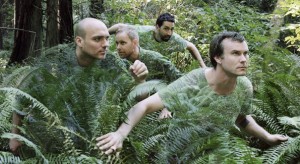
Sunny Day Real Estate’s first reunion back in 1997 was monumental news. Given their internet-based break-up just a few years earlier and their numerous idiosyncrasies (Jeremy Enigk’s conversion to Christianity, not playing shows in California, the Nordstrom ad, the pink artwork of LP2)—not to mention their profoundly affecting music—a wide swath of the indie world viewed How It Feels to Be Something On as the second coming, religious implications intended. I wasn’t nearly as charged. I had only recently gotten into Diary and LP2, so I’d missed out on that cycle of despair and joy. As such, my response to their reunion was malaise: I passed on the SDRE mk. II tours, waited a few years to get around to How It Feels and even longer to forget about The Rising Tide. Bassist Nate Mendel’s absence from the latter incarnation is mammoth—even with a slew of standouts on How It Feels, SDRE sorely missed his fluid basslines, as the rotating cast of stand-ins could never fill his shoes. The group later swapped guitarist Dan Hoerner for Mendel in the three-piece semi-reunion of The Fire Theft, but the songs were underwhelming. It’s hard not to wonder if their legacy was better off cloaked in the inscrutable mysteries of their would-be swansong, LP2.
Yet even with the missteps of The Rising Tide and its prog-rock fetishism, The Fire Theft, and Jeremy Enigk’s decidedly milquetoast recent solo albums, history has favored Sunny Day Real Estate over virtually all of their emo contemporaries. (Jawbreaker is the only other group on par from that era.) Diary and LP2 just received well-earned reissues from Sub Pop, further cementing their respective statuses as the epochal second-wave emo debut and its mysterious follow-up. These albums aren’t quite perfect—the former suffers from a sagging back-end, the latter occasionally confirms Enigk and Hoerner’s barely finished lyrics—but they hold up. Do the Get-Up Kids? Do Christie Front Drive or Mineral? Do the Promise Ring? The list could go on, spiraling downward into later groups and smaller fan bases, but there’s little point.* Those groups were indebted to Sunny Day Real Estate’s blueprint, but rarely lived up to it. Is the Promise Ring’s “East Texas Avenue” anything other than their SDRE homage? Weren’t the Appleseed Cast (originally named December’s Tragic Drive) ostensibly a SDRE tribute band on their first album? What prevented these groups from approximating the charge of “Seven,” “In Circles,” or “Rodeo Jones” wasn’t just inspiration, it was also talent. When Mendel and drummer William Goldsmith joined the Foo Fighters, it felt like a genius coup by Dave Grohl: steal the best bass player and the best drummer from the Seattle indie scene. So many 1990s emo bands took the amateur status of lo-fi indie rock to the next level by embracing sloppy vocals and ragged instrumentation as trappings of the genre, writing them off as you know, being so emotional. SDRE were straight professionials; Diary and LP2 confirm emo’s origins in Washington, D.C. hardcore groups like Rites of Spring by living up to that city’s emphasis on technical precision. No surprise that they shared a split single with Shudder to Think.
Where Sunny Day Real Estate falls into the recent slew of reunited acts is unclear at the moment. Their 1997 reunion was initially focused on the music—first the intended rarities album, then How It Feels—not the shows, although those certainly came around. The 2009 reunion started out as a promotional tour for the reissues and may blossom into a new record, as the group keeps hinting. There’s a number of comparative examples to cite: the Pixies reunited for the money, Shudder to Think reunited for the shows, Mission of Burma, Dinosaur Jr., and Polvo reunited for the shows and then new material. Tossing aside the Pixies’ ongoing cash grab (Mendel’s making too much in the Foo Fighters to doubt his interest), SDRE is divided between the Shudder to Think and the Polvo paths. Will this tour end with a greatest hits live album or will the one new song multiply into a revitalized new album? Given how Shudder to Think played the Paradise and SDRE played the much larger House of Blues, SDRE has more encouragement to stick around, so my hopes for a new record might come true. Yet there’s no reason to continue if they don’t slay in concert, so this show was the first test of SDRE mk. III for me.
Considering how pervasive Sunny Day Real Estate’s influence was on mid-1990s emo, any number of second- or third-wave groups could’ve easily opened this show, which made the Jealous Sound a welcome selection. They’re not a groundbreaking or influential band, but a solid, melodic blend of late 1990s emo and catchy indie rock. Singer Blair Shehan formed the group after the dissolution of Knapsack in 2000, teaming up with Sunday’s Best** guitarist Pedro Benito and a shifting rhythm section, which may or may not still include former Jawbox/Shudder to Think drummer Adam Wade. Toning down the throat-shredding screams and dynamic range of Knapsack’s best songs (“Perfect,” “Courage Was Confused”) for a more polished version of their straight-ahead collisions of emo and pop-punk (“Skip the Details,” “Decorate the Spine,” “Katharine the Grateful”), the Jealous Sound’s first EP had a long stay in my discman back in 2000. Five songs, no filler, with three highlights: “What’s Wrong Is Everywhere” alternated between a big opening riff and a melancholy keyboard verse part as Shehan whisper-sung Sooyoung Park-style through his best melodies to date; “Priceless” added some needed urgency with a strafing solo and a circular chorus outro; and “Anxious Arms” threw major hooks out with reckless abandon over the half-time outro. When so many of their peers (The Promise Ring, the Get-Up Kids, Mineral, even Sunny Day Real Estate) were struggling with how to evolve without alienating their core audience of horned-rimmed emo kids, The Jealous Sound figured out how to polish their sound without losing their energy, ripping off U2, going prog-rock, or dabbling in indie-tronica.
Yet the follow-up LP, 2003’s Kill Them with Kindness, couldn’t match the EP. Maybe it was the push and pull from a major-label flirtation, but there’s a palpable weariness present. A decidedly subpar version of “Anxious Arms” suffered from a huskier Shehan vocal, the back-end of the record had a few snoozers, and the hooks seemed less natural and more forced. Just like the EP, there are three clear standouts: opener “Hope for Us” goes all-out with its enthusiastic “Oh-oh-oh” bridge vocals; the new wave keyboards of “The Fold Out” set up the racing drumming of its ending; and the album closer “Abandon! Abandon!” recalls the passionate strains of Knapsack. Yet three of twelve is a mediocre batting average at best.
What caused the delay between Kill Them and 2008’s Got Friends EP is unclear—this blog post insinuates that Shehan went crazy, the comments say that he tried starting a family—but the digital-only release was an odds-and-sods CD5 with two remixes of the title track. “Got Friends” is a nice enough pop song, but it’s a safe bet that no one on earth was pining for Jealous Sound remixes. This reunion turns this EP from a posthumous release to a stop-gap before a new album, which is supposedly underway.
Judging from their performance, Shehan and company seem reenergized, so I’m cautiously hopeful for the next album. They played the six highlights of their catalog, with the semi-screams of “Abandon! Abandon!” giving the set a much-needed edge and “Anxious Arms” closing their set on a high note. There’s a bit of the Hey Mercedes syndrome*** with Shehan’s rhythm guitar parts (staccato strums at the same tempo) and his Knapsack-style vocal strains need greater frequency (especially if they’re going to be so high in the mix), things I don’t expect to change, but reminiscing about circa-2000 post-emo will bring out the nitpicker in me.
To no surprise given the recent reissues of Diary and LP2, Sunny Day Real Estate did very little reminiscing about circa-2000 post-emo, or even post-1995 emo. Except for one song from How It Feels and their unnamed new song, the set was comprised of selections from those remastered albums, and I can’t argue with that decision. It felt less like crass promotion and more like a combination of nostalgia and revisionist history. “Remember when it was the four of us and we put out those two great albums? That sure was great, even if we didn’t appreciate it at the time. Let’s imagine all of the other stuff never happened.” That’s the rose-colored glasses version of their situation, sure, but there was no sense of SDRE sleepwalking through the classics like the Pixies did. (“Let’s play both versions of ‘Wave of Mutiliation,’ I mean, they want to hear them, right?”) SDRE played the classics, but they gave them the passion and respect they deserved.
Unlike Polvo, who essentially rewrote all of their old material for the new tours, Sunny Day Real Estate played the songs the way people knew them. The magic was remembering just how hard they rocked. My wife commented that SDRE was far more dude-rock than she remembered, which is certainly less the case on their later records (wait, is there anything more dude-rock than ripping off Rush?), but it’s hard to argue with how hard “Seven” hits, how the angular conclusion of “Theo B” recalls a Chavez riff factory, or how abrasive the chorus of “48” is. There are plenty of quiet moments, like the lilting ache of “Song About an Angel,” the gentle push of “Sometimes,” the verses of “Grendel” and “47,” and the graceful open of “Guitar and Video Games,” but all of those songs have big rock payoffs, too. Virtually every song made me appreciate it more, not an easy task considering my fondness for their albums. The new song (“10”) felt a bit breezier than its peers in the verses, but the chorus was excellent. This horrible YouTube clip of it will have to tide you over until its eventual release.
Not to take away from Dan Hoerner’s visible joy or Jeremy Enigk’s strong vocal performance, but there was no doubt who stole the show. William Goldsmith is an absolute joy to watch, combining the precision of proper posture drummers like the Dismemberment Plan’s Joe Easley, Juno’s Greg Ferguson, and Shiner’s Tim Dow (my favorite type of drummer to watch) with an absolutely ferocious attack for every fill. I remember seeing him on Saturday Night Live playing with the Foo Fighters and thinking “Damn, what a great drummer,” but he’s even better when he’s playing his own material. Apparently he had some issues later in the show, having to bail on LP2 bonus track “Spade and Parade,” but that’s the danger in giving it your all and then some.
It’s impossible not to mention the two unintentionally hilarious moments of the evening. First, Nate Mendel sounded downright bored during the verses of the lone How It Feels song, “Guitar and Video Games,” plodding through the root notes like he was carrying an albatross. He’s a downright great bass player—he was on Juno’s A Future Lived in Past Tense, after all—but don’t expect any more How It Feels songs to nudge their way into the set list without significant reworking. Second, Dan Hoerner had a spotlight during the jagged chord slashes of the elongated outro to “J’Nuh.” I laughed out loud at its appearance; I could imagine Hoerner thinking, “I love being back in this band, but this is what you guys get for keeping me out of the Fire Theft.” Less amusing was the inevitable encore for “In Circles,” but it’s not like I left early out of principle. My only other complaint was the absence of “Rodeo Jones” and “8,” two of my favorite songs from LP2, but I imagine the group still views those songs as leftovers to some capacity. But what leftovers!
Revisiting these songs made me realize just how far emo has come. Today’s popular emo groups do not emulate the obfuscated poetry of Enigk or his growling falsetto abstractions, and thinking of his vocal performance from “48” somehow filtering its way to modern rock radio brought a smile to my face after the show. Nor do they have the DC chops of Enigk, Hoerner, Mendel, or especially Goldsmith. If this tour, this reunion is about rebuilding their legacy, restarting the group from when they were last unquestionably great, it could have the potential of rebranding the whole genre? Associating emo with great songwriting, inspired performances, and technical precision as opposed to black fingernail polish and horned-rim glasses would be a good thing, right?
* For the sake of argument, I’ll vouch for Castor (who I usually lumped in with Midwestern rock like Shiner rather than emo contemporaries like Braid), a greatest-hits array from Braid, a handful of Knapsack songs, the similarly Midwestern Boys Life, and the key emo groups from DC. From this decade only Cursive (Domestica, Burst and Bloom, and The Ugly Organ) and the Casket Lottery (Survival Is for Cowards) stand out, although I’m not exactly devoting hours of my time to finding new, hip emo bands. There are probably other groups depending on your scope of the genre, but so many of the definite emo acts of the era have aged terribly. See: The Promise Ring.
** Sunday’s Best’s “Sons of the Second String” was so much better than anything that made it to their Polyvinyl debut LP, Poised to Break, that they earned the bitter irony of its title.
*** Hey Mercedes had a few great songs, especially “Bells,” but seeing them in concert a handful of times before their first LP stressed just how similar all of their songs were in tempo, guitar rhythm, and drumming starts and stops. It’s my go-to example for diminishing returns.
|
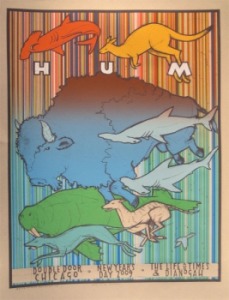
Considering that the only bands I see nowadays—seemingly, at least—are groups that I loved in high school (Polvo, Shudder to Think) that have reformed out of some combination of nostalgia and profit, adding Hum to that list shouldn’t be a huge surprise. Hum’s been doing these semi-reunions every two to three years since they officially went on hiatus with a New Year’s Eve show 12/31/1999. They played Furnacefest in 2003 (with a warm-up show in Champaign) and Rockfest in Champaign in 2005, so the two shows at the Double Door were right on schedule. The surprise, however, is that I was scheduled to be in Chicago for these performances. I had assumed that Hum would only play shows when I was firmly planted in the east coast, whether visiting family or moving there for graduate school. I was initially afraid that I’d missed my opportunity by waffling on the $65 New Year’s Eve show until it had sold out, but the addition of more manageable New Year’s Day show for $20 made my prior hesitation easier. I was going to see Hum for the first time in almost eleven years.
The only other time I saw Hum was at Irving Plaza in New York City in February of 1998 as a seventeen-year-old junior in high school. As we drove to the Double Door, my wife asked me what I thought of that show and I laughed, because it’s impossible to look back at that show with any semblance of a critical mindset. Getting to see my favorite band at seventeen was all shock and awe. Heroic Doses and Swervedriver opened up for Hum and I remember absolutely nothing about their sets. What I remember is the push of the billowing mosh pit, the thrill of hearing those songs live, the ringing in my ears from not wearing earplugs, and seeing Bush’s Gavin Rossdale and No Doubt’s Gwen Stefani as we waited outside of the club to meet the band. Tim Lash’s guitar tone? Matt Talbott’s live vocals? Bryan St. Pere’s fills? Beats me.
While I still count them as one of my favorite groups, it’s been years since I’ve listened to Hum almost exclusively. I’ll save the details of my full-blown Hum obsession and its passing for a pending article on You’d Prefer an Astronaut, but the short version is that I still listen to their last three albums from time to time, but not on a daily basis like I did in high school. (Sorry Fillet Show.) As frustrated as I was with the eleven-year wait, it did help my recharge my potential enthusiasm and/or nostalgia for the concert.
The openers for both shows were quite familiar for any Hum fan who kept track of their touring partners. Dianogah’s opening set displayed their progress since 1997’s As Seen From Above. Still channeling largely instrumental double-bass math-rock, Dianogah added some flair with female vocals on a few songs, accompanying guitar or keyboard on others, and a few aggressive songs that presumably were from their newest LP, the nigh-unpronounceable Qhnnnl. I’m tempted to pick that one up to bolster my copies of Battle Champions and the Team Dianogah 2 Swedish single, but I opted to pick up the Bird Machine posters for both evenings from poster guru and Dianogah bassist Jay Ryan.
As excited as I was for seeing Hum, I would have been just as psyched for a Shiner reunion (a group I saw eleven times in six cities, or, in other words, the anti-Hum), but catching Allen Epley’s The Life and Times again was a fine alternative. Their shoegaze-meets-math-rock aesthetic loses some detail in the live setting, but the songs from their forthcoming Tragic Boogie LP (coming out on Arena Rock Records in April) came across well. I missed hearing a few of my favorite songs from Suburban Hymns like “Mea Culpa,” “A Chorus of Crickets,” and “Muscle Cars” this time, but at least they played the excellent “The Sound of the Ground” from the Magician EP. Look for them on tour in the spring when their album comes out.
With a seemingly endless string of Rush songs between sets, I began to wonder if Hum was playing an elaborate joke on the audience. But once the smoke machine started up and the house lights dimmed down to a blue glow, Hum came out to enthusiastic applause and launched into “Isle of the Cheetah.” It didn’t take long for the first coordination hiccup to hit, but once the song’s intro passed and it hit overdrive, they were back on track. Tim Lash’s leads were spot-on in this song and throughout, and he even added some flourishes. Immediately I was struck by how metal the guitar tones sounded, especially Lash’s guitar, but that influence was always present during his tenure in the band. Everything else was as I remembered it: Talbott’s nerdy vocals bursting out with emotion on “The Pod,” Dimpsey’s solid bass lines, and Bryan St. Pere’s forceful drumming. I don’t remember Talbott being quite so funny at the Irving Plaza show, but the numerous Centaur shows I caught during college were as memorable for his stand-up bits as the actual songs.
The set represented their final three albums equally, with “Iron Clad Lou,” “Pewter,” “Shovel,” and “Winder” from Electra 2000, “The Pod,” “Stars,” “Suicide Machine,” “I’d Like Your Hair Long,” and “I Hate It Too” from YPAA, and “Isle of the Cheetah,” “Comin’ Home,” “Ms. Lazarus,” “Afternoon with the Axolotls,” and “Green to Me” from Downward Is Heavenward, plus the unreleased rocker “Inklings.” I was a bit surprised to hear the throat-scraping screams of “Pewter” and “Shovel” in concert, but the encore of “Winder” was an absolute thrill. I could gripe about “Little Dipper,” “Dreamboat,” “Pinch & Roll,” and “Diffuse” being absent from the set list, but the arc of the night worked well, with the main set ending with the extended outro jam on “I Hate It Too” (marred slightly by Bryan St. Pere losing his place for a few bars) and the encore ending with a rock-solid rendition of “I’d Like Your Hair Long.”
The best part of the evening was remembering just how great those songs are, whether it was the thunderous drum salvo that launches “Iron Clad Lou” into gear, the churning bass line of “Winder,” the guitar coloring for the mid-tempo “Suicide Machine,” the quiet intro of “I Hate It Too,” or the Cadillac-selling riff of “Stars.” Talbott’s lyrics are still wonderful, especially on the You’d Prefer an Astronaut, and it’s easy to overlook a few musical missteps along the way with that set list. Unlike some of the other reunited bands that I’ve seen, Hum never went away for long enough to forget the muscle memory of how to perform those songs or to lose the passion for playing them, so they’re essentially the same band put into cryogenic freezing.
It’s still somewhat astonishing that I finally made it to one of these shows. While I’d be thrilled if Hum released new music or at least recorded a studio version of “Inklings” and put it out as a single, the odds of either of those things happening are nil, so I’m glad that I could add something to my lingering super-fandom. I’ll just have to remember to be in Illinois in 2011.
|
|

